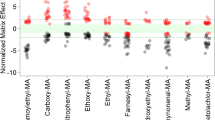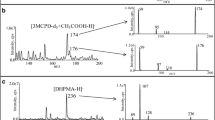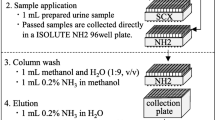Abstract
Mercapturic acids (MAs) are metabolic end products formed from conjugates between glutathione and electrophilic compounds. MAs are, therefore, suitable biomarkers of exposure to toxicants, which are either electrophiles by themselves or metabolized to electrophilic intermediates. We developed and validated two LC-MS/MS methods which allow the complementary, rapid, and sensitive determination of MAs derived from acrolein, acrylamide, acrylonitrile, benzene, 1,3-butadiene, crotonaldehyde, N,N-dimethylformamide, ethylene, ethylene oxide, vinyl chloride, propylene oxide, styrene, toluene as well as methylating and ethylating agents. Since separate determinations of single or small groups of MAs are time-consuming and expensive, we multiplexed several individual methods into two LC-MS/MS methods covering 18 individual mercapturic acids. Method validation according to FDA guidelines showed excellent results in terms of robustness, accuracy, and sensitivity of the methods. Moreover, the use of a minimal, simple, and straightforward sample cleanup procedure further accelerated the analytical workflow, which allows a time- and cost-efficient analysis of up to 18 MAs derived from various toxicants in environmental levels. The methods were applied to urine samples derived from a strictly diet-controlled clinical study, including 25 smoking and 25 non-smoking subjects. Significant increase in the urine concentrations in smokers as compared to non-smokers (p < 0.01; Student t test) was observed for 13 individual MAs. Moreover, a dose dependence was obtained for the majority of the analytes. In conclusion, the newly developed assays represent a powerful tool for the fast and reliable quantification of 18 MAs in clinical studies. A first method application suggests several suitable biomarkers for nine relevant toxicants in tobacco smoke.



Similar content being viewed by others
References
Hecht SS (2002) Human urinary carcinogen metabolites: biomarkers for investigating tobacco and cancer. Carcinogenesis 23:907–922
Blount BC, Kobelski RJ, Mcelprang DO, Ashley DL, Morrow JC, Chambers DM, Cardinali FL (2006) Quantification of 31 volatile organic compounds in whole blood using solid-phase microextraction and gas chromatography-mass spectrometry. J Chromatogr B Analyt Technol Biomed Life Sci 832:292–301
Chambers DM, Ocariz JM, Mcguirk MF, Blount BC (2011) Impact of cigarette smoking on volatile organic compound (VOC) blood levels in the U.S. population: NHANES, 2003–2004. Environ Int 37:1321–1328
Chambers DM, Mcelprang DO, Waterhouse MG, Blount BC (2006) An improved approach for accurate quantitation of benzene, toluene, ethylbenzene, xylene, and styrene in blood. Anal Chem 78:5375–5383
Urban M, Kavvadias D, Riedel K, Scherer G, Tricker AR (2006) Urinary mercapturic acids and a hemoglobin adduct for the dosimetry of acrylamide exposure in smokers and non-smokers. Inhal Toxicol 18:831–839
Scherer G, Newland K, Papadopoulou E, Minet E (2014) A correlation study applied to biomarkers of internal and effective dose for acrylonitrile and 4-aminobiphenyl in smokers. Biomarkers 19:291–301
Carmella SG, Chen M, Han S, Briggs A, Jensen J, Hatsukami DK, Hecht SS (2009) Effects of smoking cessation on eight urinary tobacco carcinogen and toxicant biomarkers. Chem Res Toxicol 22:734–741
Ding YS, Blount BC, Valentin-Blasini L, Applewhite HS, Xia Y, Watson CH, Ashley DL (2009) Simultaneous determination of six mercapturic acid metabolites of volatile organic compounds in human urine. Chem Res Toxicol 22:1018–1025
Feng S, Roethig HJ, Liang Q, Kinser R, Jin Y, Scherer G, Urban M, Engl J, Riedel K (2006) Evaluation of urinary 1-hydroxypyrene, S-phenylmercapturic acid, trans, trans-muconic acid, 3-methyladenine, 3-ethyladenine, 8-hydroxy-2′-deoxyguanosine and thioethers as biomarkers of exposure to cigarette smoke. Biomarkers 11:28–52
Scherer G, Urban M, Hagedorn HW, Serafin R, Feng S, Kapur S, Muhammad R, Jin Y, Sarkar M, Roethig HJ (2010) Determination of methyl-, 2-hydroxyethyl- and 2-cyanoethylmercapturic acids as biomarkers of exposure to alkylating agents in cigarette smoke. J ChromatogrB Analyt Technol Biomed Life Sci 878:2520–2528
De Rooij BM, Commandeur JN, Vermeulen NP (1998) Mercapturic acids as biomarkers of exposure to electrophilic chemicals: applications to environmental and industrial chemicals. Biomarkers 3:239–303
Commandeur JN, Stijntjes GJ, Vermeulen NP (1995) Enzymes and transport systems involved in the formation and disposition of glutathione S-conjugates. Pharmacol Rev 47:271–330
Van Welie RTH, Van Dijck RGJM, Vermeulen NPE (1992) Mercapturic acids, protein adducts, and DNA adducts as biomarkers of electrophilic chemicals. Crit Rev Toxicol 22:271–306
Gelpi E (1995) Biomedical and biochemical applications of liquid chromatography-mass spectrometry. J Chromatogr A 703:59–80
Slatter JG, Rashed MS, Pearson PG, Han DH, Baillie TA (1991) Biotransformation of methyl isocyanate in the rat. Evidence for glutathione conjugation as a major pathway of metabolism and implications for isocyanate-mediated toxicities. Chem Res Toxicol 4:157–161
Eckert E, Drexler H, Goen T (2010) Determination of six hydroxyalkyl mercapturic acids in human urine using hydrophilic interaction liquid chromatography with tandem mass spectrometry (HILIC-ESI-MS/MS). J Chromatogr B Analyt Technol Biomed Life Sci 878:2506–2514
Eckert E, Goen T (2014) Rapid determination of four short-chain alkyl mercapturic acids in human urine by column-switching liquid chromatography-tandem mass spectrometry. J Chromatogr B Analyt Technol Biomed Life Sci 965:54–60
Mascher DG, Mascher HJ, Scherer G, Schmid ER (2001) High-performance liquid chromatographic-tandem mass spectrometric determination of 3-hydroxypropylmercapturic acid in human urine. J Chrom B 750:163–169
Paci E, Pigini D, Cialdella AM, Faranda P, Tranfo G (2007) Determination of free and total S-phenylmercapturic acid by HPLC/MS/MS in the biological monitoring of benzene exposure. Biomarkers 12:111–122
Schettgen T, Musiol A, Alt A, Kraus T (2008) Fast determination of urinary S-phenylmercapturic acid (S-PMA) and S-benzylmercapturic acid (S-BMA) by column-switching liquid chromatography-tandem mass spectrometry. J ChromatogrB Analyt Technol Biomed Life Sci 863:283–292
Schettgen T, Musiol A, Alt A, Ochsmann E, Kraus T (2009) A method for the quantification of biomarkers of exposure to acrylonitrile and 1,3-butadiene in human urine by column-switching liquid chromatography-tandem mass spectrometry. Anal Bioanal Chem 393:969–981
Schettgen T, Musiol A, Kraus T (2008) Simultaneous determination of mercapturic acids derived from ethylene oxide (HEMA), propylene oxide (2-HPMA), acrolein (3-HPMA), acrylamide (AAMA) and N, N-dimethylformamide (AMCC) in human urine using liquid chromatography/tandem mass spectrometry. Rapid Commun Mass Spectrom 22:2629–2638
Sterz K, Kohler D, Schettgen T, Scherer G (2010) Enrichment and properties of urinary pre-S-phenylmercapturic acid (pre-SPMA). J ChromatogrB Analyt Technol Biomed Life Sci 878:2502–2505
Sterz K, Scherer G, Krumsiek J, Theis FJ, Ecker J (2012) Identification and quantification of 1-hydroxybutene-2-yl mercapturic acid in human urine by UPLC-HILIC-MS/MS as a novel biomarker for 1,3-butadiene exposure. Chem Res Toxicol 25:1565–1567
Urban M, Gilch G, Schepers G, Van Miert E, Scherer G (2003) Determination of the major mercapturic acids of 1,3-butadiene in human and rat urine using liquid chromatography-tandem mass spectrometry. J Chrom B 796:131–140
Zhang X, Xiong W, Shi L, Hou H, Hu Q (2014) Simultaneous determination of five mercapturic acid derived from volatile organic compounds in human urine by LC-MS/MS and its application to relationship study. J Chromatogr B Analyt Technol Biomed Life Sci 967:102–109
Alwis KU, Blount BC, Britt AS, Patel D, Ashley DL (2012) Simultaneous analysis of 28 urinary VOC metabolites using ultra high performance liquid chromatography coupled with electrospray ionization tandem mass spectrometry (UPLC-ESI/MSMS). Anal Chim Acta 750:152–160
Food and Drug Administration (FDA) (2012) Harmful and potentially harmful constituents in tobacco products and tobacco smoke. In: http://federalregister.gov/a/2012-07727 (last Assessed 6 Feb 2014). Food and Drug Administration (FDA)
Food and Drug Administration (Fda) (2001) Guidance for industry—bioanalytical method validation. In: http://www.fda.gov/downloads/Drugs/Guidances/ucm070107.pdf (last Assessed 22 July 2014). Food and Drug Administration (FDA) p1-22
Meger M, Meger-Kossien I, Schuler-Metz A, Janket D, Scherer G (2002) Simultaneous determination of nicotine and eight nicotine metabolites in urine of smokers using liquid chromatography-tandem mass spectrometry. J Chromatogr B Analyt Technol Biomed Life Sci 778:251–261
Huang YF, Wu KY, Liou SH, Uang SN, Chen CC, Shih WC, Lee SC, Huang CC, Chen ML (2010) Biological monitoring for occupational acrylamide exposure from acrylamide production workers. Int Arch Occup Environ Health 84:303–313
Negri S, Maestri L, Andreoli R, Manini P, Mutti A, Imbriani M (2006) Mercapturic acids of styrene in man: comparability of the results obtained by LC/MS/MS and by HPLC-fluorimeter, and stability of samples under different storage conditions. Toxicol Lett 162:225–233
Scherer G, Urban M, Hagedorn HW, Feng S, Kinser R, Sarkar M, Liang Q, Roethig HJ (2007) Determination of two mercapturic acids related to crotonaldehyde in human urine: influence of smoking. Hum Exp Toxicol 26:37–47
Boettcher MI, Schettgen T, Kutting B, Pischetsrieder M, Angerer J (2005) Mercapturic acids of acrylamide and glycidamide as biomarkers of the internal exposure to acrylamide in the general population. Mutat Res 580:167–176
Albertini RJ, Sram RJ, Vacek PM, Lynch J, Nicklas JA, Van Sittert NJ, Boogaard PJ, Henderson RF, Swenberg JA, Tates AD, Ward JB, Jr., Wright M, Ammenheuser MM, Binkova B, Blackwell W, De Zwart FA, Krako D, Krone J, Megens H, Musilova P, Rajska G, Ranasinghe A, Rosenblatt JI, Rossner P, Rubes J, Sullivan L, Upton P, Zwinderman AH (2003) Biomarkers in Czech workers exposed to 1,3-butadiene: a transitional epidemiologic study. Res.Rep.Health Eff.Inst.:1–141
Eckert E, Leng G, Gries W, Goen T (2012) A method for the simultaneous determination of mercapturic acids as biomarkers of exposure to 2-chloroprene and epichlorohydrin in human urine. J Chromatogr B Analyt Technol Biomed Life Sci 889–890:69–76
Reska M, Ochsmann E, Kraus T, Schettgen T (2010) Accurate quantification of mercapturic acids of styrene (PHEMAs) in human urine with direct sample injection using automated column-switching high-performance liquid chromatography coupled with tandem mass spectrometry. Anal Bioanal Chem 397:3563–3574
Conflict of interest
The authors declare that they have no conflict of interest.
Author information
Authors and Affiliations
Corresponding author
Rights and permissions
About this article
Cite this article
Pluym, N., Gilch, G., Scherer, G. et al. Analysis of 18 urinary mercapturic acids by two high-throughput multiplex-LC-MS/MS methods. Anal Bioanal Chem 407, 5463–5476 (2015). https://doi.org/10.1007/s00216-015-8719-x
Received:
Revised:
Accepted:
Published:
Issue Date:
DOI: https://doi.org/10.1007/s00216-015-8719-x




